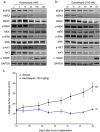The HSP90 inhibitor ganetespib potentiates the antitumor activity of EGFR tyrosine kinase inhibition in mutant and wild-type non-small cell lung cancer
- PMID: 25077897
- PMCID: PMC4457934
- DOI: 10.1007/s11523-014-0329-6
The HSP90 inhibitor ganetespib potentiates the antitumor activity of EGFR tyrosine kinase inhibition in mutant and wild-type non-small cell lung cancer
Abstract
Small molecule inhibitors of epidermal growth factor receptor (EGFR) tyrosine kinase activity, such as erlotinib and gefitinib, revolutionized therapy for non-small cell lung cancer (NSCLC) patients whose tumors harbor activating EGFR mutations. However, mechanisms to overcome the invariable development of acquired resistance to such agents, as well as realizing their full clinical potential within the context of wild-type EGFR (WT-EGFR) disease, remain to be established. Here, the antitumor efficacy of targeted EGFR tyrosine kinase inhibitors (TKIs) and the HSP90 inhibitor ganetespib, alone and in combination, were evaluated in NSCLC. Ganetespib potentiated the efficacy of erlotinib in TKI-sensitive, mutant EGFR-driven NCI-HCC827 xenograft tumors, with combination treatment causing significant tumor regressions. In erlotinib-resistant NCI-H1975 xenografts, concurrent administration of ganetespib overcame erlotinib resistance to significantly improve tumor growth inhibition. Ganetespib co-treatment also significantly enhanced antitumor responses to afatinib in the same model. In WT-EGFR cell lines, ganetespib potently reduced cell viability. In NCI-H1666 cells, ganetespib-induced loss of client protein expression, perturbation of oncogenic signaling pathways, and induction of apoptosis translated to robust single-agent activity in vivo. Dual ganetespib/erlotinib therapy induced regressions in NCI-H322 xenograft tumors, indicating that the sensitizing properties of ganetespib for erlotinib were conserved within the WT-EGFR setting. Mechanistically, combined ganetespib/erlotinib exposure stabilized EGFR protein levels in an inactive state and completely abrogated extracellular-signal-regulated kinase (ERK) and AKT signaling activity. Thus, selective HSP90 blockade by ganetespib represents a potentially important complementary strategy to targeted TKI inhibition alone for inducing substantial antitumor responses and overcoming resistance, in both the mutant and WT-EGFR settings.
Figures




Similar articles
-
Ganetespib in Epidermal Growth Factor Receptor-Tyrosine Kinase Inhibitor-resistant Non-small Cell Lung Cancer.Anticancer Res. 2019 Apr;39(4):1767-1775. doi: 10.21873/anticanres.13283. Anticancer Res. 2019. PMID: 30952716
-
Targeting heat shock protein 90 with CUDC-305 overcomes erlotinib resistance in non-small cell lung cancer.Mol Cancer Ther. 2009 Dec;8(12):3296-306. doi: 10.1158/1535-7163.MCT-09-0538. Mol Cancer Ther. 2009. PMID: 19952121
-
Combined vascular endothelial growth factor receptor and epidermal growth factor receptor (EGFR) blockade inhibits tumor growth in xenograft models of EGFR inhibitor resistance.Clin Cancer Res. 2009 May 15;15(10):3484-94. doi: 10.1158/1078-0432.CCR-08-2904. Epub 2009 May 15. Clin Cancer Res. 2009. PMID: 19447865 Free PMC article.
-
Irreversible EGFR inhibitors in the treatment of advanced NSCLC.Curr Pharm Des. 2014;20(24):3894-900. doi: 10.2174/13816128113196660764. Curr Pharm Des. 2014. PMID: 24138713 Review.
-
Advances in molecular-based personalized non-small-cell lung cancer therapy: targeting epidermal growth factor receptor and mechanisms of resistance.Cancer Med. 2015 Nov;4(11):1621-32. doi: 10.1002/cam4.506. Epub 2015 Aug 26. Cancer Med. 2015. PMID: 26310719 Free PMC article. Review.
Cited by
-
Current Strategies for Treating NSCLC: From Biological Mechanisms to Clinical Treatment.Cancers (Basel). 2020 Jun 15;12(6):1587. doi: 10.3390/cancers12061587. Cancers (Basel). 2020. PMID: 32549388 Free PMC article. Review.
-
Tumor evolution in epidermal growth factor receptor mutated non-small cell lung cancer.J Thorac Dis. 2020 May;12(5):2896-2909. doi: 10.21037/jtd.2019.08.31. J Thorac Dis. 2020. PMID: 32642202 Free PMC article. Review.
-
The HSP90 Inhibitor Ganetespib Radiosensitizes Human Lung Adenocarcinoma Cells.Cancers (Basel). 2015 May 22;7(2):876-907. doi: 10.3390/cancers7020814. Cancers (Basel). 2015. PMID: 26010604 Free PMC article.
-
The Role of Heat Shock Protein 90B1 in Patients with Polycystic Ovary Syndrome.PLoS One. 2016 Apr 5;11(4):e0152837. doi: 10.1371/journal.pone.0152837. eCollection 2016. PLoS One. 2016. PMID: 27046189 Free PMC article. Clinical Trial.
-
Identification of Predictive Biomarkers of Response to HSP90 Inhibitors in Lung Adenocarcinoma.Int J Mol Sci. 2021 Mar 3;22(5):2538. doi: 10.3390/ijms22052538. Int J Mol Sci. 2021. PMID: 33802597 Free PMC article.
References
Publication types
MeSH terms
Substances
LinkOut - more resources
Full Text Sources
Other Literature Sources
Medical
Research Materials
Miscellaneous

